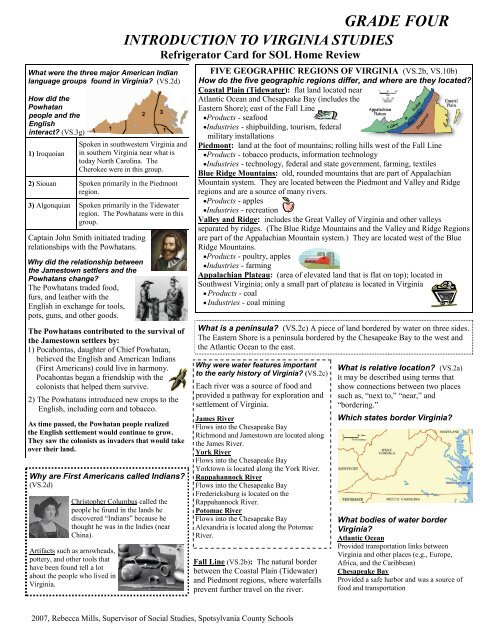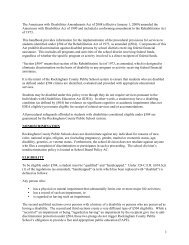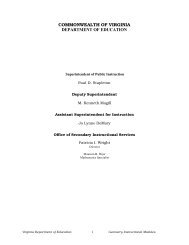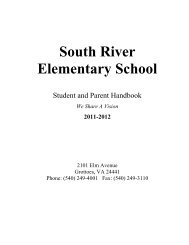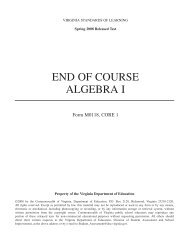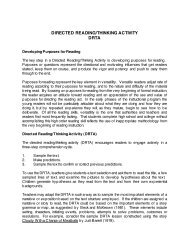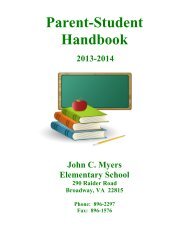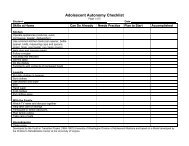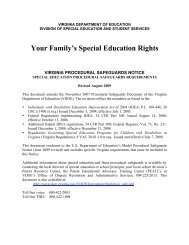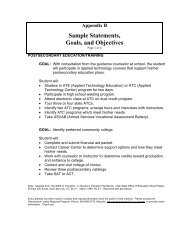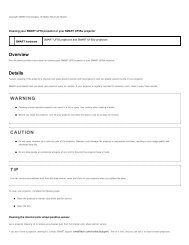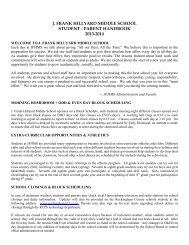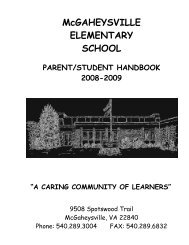Refrigerator Card - Loudoun County Public Schools
Refrigerator Card - Loudoun County Public Schools
Refrigerator Card - Loudoun County Public Schools
Create successful ePaper yourself
Turn your PDF publications into a flip-book with our unique Google optimized e-Paper software.
What were the three major American Indian<br />
language groups found in Virginia? (VS.2d)<br />
How did the<br />
Powhatan<br />
people and the<br />
English<br />
interact? (VS.3g)<br />
Spoken in southwestern Virginia and<br />
1) Iroquoian in southern Virginia near what is<br />
today North Carolina. The<br />
Cherokee were in this group.<br />
2) Siouan Spoken primarily in the Piedmont<br />
region.<br />
3) Algonquian Spoken primarily in the Tidewater<br />
region. The Powhatans were in this<br />
group.<br />
Captain John Smith initiated trading<br />
relationships with the Powhatans.<br />
Why did the relationship between<br />
the Jamestown settlers and the<br />
Powhatans change?<br />
The Powhatans traded food,<br />
furs, and leather with the<br />
English in exchange for tools,<br />
pots, guns, and other goods.<br />
The Powhatans contributed to the survival of<br />
the Jamestown settlers by:<br />
1) Pocahontas, daughter of Chief Powhatan,<br />
believed the English and American Indians<br />
(First Americans) could live in harmony.<br />
Pocahontas began a friendship with the<br />
colonists that helped them survive.<br />
2) The Powhatans introduced new crops to the<br />
English, including corn and tobacco.<br />
As time passed, the Powhatan people realized<br />
the English settlement would continue to grow.<br />
They saw the colonists as invaders that would take<br />
over their land.<br />
Why are First Americans called Indians?<br />
(VS.2d)<br />
Christopher Columbus called the<br />
people he found in the lands he<br />
discovered “Indians” because he<br />
thought he was in the Indies (near<br />
China).<br />
Artifacts such as arrowheads,<br />
pottery, and other tools that<br />
have been found tell a lot<br />
about the people who lived in<br />
Virginia.<br />
GRADE FOUR<br />
INTRODUCTION TO VIRGINIA STUDIES<br />
<strong>Refrigerator</strong> <strong>Card</strong> for SOL Home Review<br />
FIVE GEOGRAPHIC REGIONS OF VIRGINIA (VS.2b, VS.10b)<br />
How do the five geographic regions differ, and where are they located?<br />
Coastal Plain (Tidewater): flat land located near<br />
Atlantic Ocean and Chesapeake Bay (includes the<br />
Eastern Shore); east of the Fall Line<br />
•Products - seafood<br />
•Industries - shipbuilding, tourism, federal<br />
military installations<br />
Piedmont: land at the foot of mountains; rolling hills west of the Fall Line<br />
•Products - tobacco products, information technology<br />
•Industries - technology, federal and state government, farming, textiles<br />
Blue Ridge Mountains: old, rounded mountains that are part of Appalachian<br />
Mountain system. They are located between the Piedmont and Valley and Ridge<br />
regions and are a source of many rivers.<br />
•Products - apples<br />
•Industries - recreation<br />
Valley and Ridge: includes the Great Valley of Virginia and other valleys<br />
separated by ridges. (The Blue Ridge Mountains and the Valley and Ridge Regions<br />
are part of the Appalachian Mountain system.) They are located west of the Blue<br />
Ridge Mountains.<br />
•Products - poultry, apples<br />
•Industries - farming<br />
Appalachian Plateau: (area of elevated land that is flat on top); located in<br />
Southwest Virginia; only a small part of plateau is located in Virginia<br />
• Products - coal<br />
• Industries - coal mining<br />
What is a peninsula? (VS.2c) A piece of land bordered by water on three sides.<br />
The Eastern Shore is a peninsula bordered by the Chesapeake Bay to the west and<br />
the Atlantic Ocean to the east.<br />
Why were water features important<br />
to the early history of Virginia? (VS.2c)<br />
Each river was a source of food and<br />
provided a pathway for exploration and<br />
settlement of Virginia.<br />
James River<br />
Flows into the Chesapeake Bay<br />
Richmond and Jamestown are located along<br />
the James River.<br />
York River<br />
Flows into the Chesapeake Bay<br />
Yorktown is located along the York River.<br />
Rappahannock River<br />
Flows into the Chesapeake Bay<br />
Fredericksburg is located on the<br />
Rappahannock River.<br />
Potomac River<br />
Flows into the Chesapeake Bay<br />
Alexandria is located along the Potomac<br />
River.<br />
Fall Line (VS.2b): The natural border<br />
between the Coastal Plain (Tidewater)<br />
and Piedmont regions, where waterfalls<br />
prevent further travel on the river.<br />
What is relative location? (VS.2a)<br />
It may be described using terms that<br />
show connections between two places<br />
such as, “next to,” “near,” and<br />
“bordering.”<br />
Which states border Virginia?<br />
What bodies of water border<br />
Virginia?<br />
Atlantic Ocean<br />
Provided transportation links between<br />
Virginia and other places (e.g., Europe,<br />
Africa, and the Caribbean)<br />
Chesapeake Bay<br />
Provided a safe harbor and was a source of<br />
food and transportation<br />
2007, Rebecca Mills, Supervisor of Social Studies, Spotsylvania <strong>County</strong> <strong>Schools</strong>
Virginia’s Indians are referred to as Eastern Woodland Indians (VS.2e)<br />
•The kinds of food they ate, the clothing they wore, and the<br />
shelters they had depended upon the seasons.<br />
•Animal skins (deerskin) were used for clothing.<br />
•Shelter was made from materials around them.<br />
The climate in Virginia is relatively mild with distinct<br />
seasons - spring, summer, fall, and winter -<br />
resulting in a variety of vegetation. (VS.2e)<br />
What are some ways they adapted to the climate and interacted with<br />
their environment to meet their basic needs?<br />
GRADE FOUR<br />
What was the impact<br />
of the arrival of<br />
women on the<br />
Jamestown<br />
settlement? (VS.3e)<br />
The arrival of women in<br />
1620 made it possible for<br />
the settlers to establish<br />
families and a more<br />
permanent settlement at Jamestown.<br />
Page 2<br />
What was the impact of the arrival of<br />
Africans on the Jamestown settlement?<br />
Africans arrived in Jamestown against their will.<br />
It is believed that they arrived as baptized<br />
Christians and therefore, were labeled indentured<br />
servants.<br />
JAMESTOWN, VIRGINIA<br />
What were the reasons for English colonization in America? (VS.3a)<br />
>England hoped to find silver and gold in America.<br />
>An American settlement would furnish raw materials that could not be grown<br />
or obtained in England, while opening new markets for trade.<br />
What were the reasons why the Jamestown settlers came to<br />
America? (VS.3a)<br />
>Jamestown was primarily an economic venture.<br />
>The stockholders of the Virginia Company of London financed the settlement<br />
of Jamestown.<br />
>Jamestown became the first permanent English settlement in North America<br />
in 1607.<br />
Where is Jamestown located?<br />
(VS.3b)<br />
When the settlers arrived in 1607,<br />
Jamestown was located on a narrow<br />
peninsula bordered on three sides by<br />
the James River. Today, Jamestown<br />
is located on an island in the James<br />
River.<br />
Why did the settlers choose the site at Jamestown? (VS.3b)<br />
>The location could easily be defended from Spanish attack by sea.<br />
The arrival of Africans<br />
made it possible to<br />
expand the tobacco<br />
economy.<br />
indentured servants:<br />
people who worked for 5 to 7 years to pay for their<br />
passage to the colonies and then they were free<br />
What hardships did the Jamestown settlers<br />
face? (VS.3f)<br />
•The site they chose to live on was marshy<br />
and lacked safe drinking water.<br />
•The settlers lacked some skills necessary to<br />
provide for themselves.<br />
•Many settlers died of starvation and disease.<br />
What changes took place to<br />
ensure survival?<br />
• arrival of two supply ships<br />
• forced work program and strong<br />
leadership of Captain John Smith<br />
• emphasis on self-sustaining<br />
agriculture<br />
The King of England granted charters<br />
to the Virginia Company of London to settle in<br />
North America. (VS.3c)<br />
The first charter of the Virginia Company of<br />
London established companies to begin<br />
colonies in the New World.<br />
America’s First Government System 1619 (VS.3d)<br />
In 1619, the governor of Virginia called a meeting of the Virginia Assembly.<br />
The Assembly included:<br />
• the governor<br />
• the governor’s council<br />
• two citizen representatives (called “burgesses”) from each of the<br />
divisions of Virginia (only white adult male landowners were<br />
considered citizens)<br />
By the 1640s, the burgesses became a separate legislative body<br />
called the Virginia House of Burgesses.<br />
The charters extended English rights<br />
to the colonists.<br />
Why was the Virginia House of<br />
Burgesses important?<br />
The Virginia House of Burgesses was the first<br />
elected legislative body in America giving<br />
settlers the opportunity to control their own<br />
government.<br />
It became the General Assembly of Virginia, which continues to this day.<br />
2007, Rebecca Mills, Supervisor of Social Studies, Spotsylvania <strong>County</strong> <strong>Schools</strong>
GRADE FOUR<br />
Page 3<br />
What effect did agriculture have on the Virginia colony?<br />
(VS.4a)<br />
The economy of the Virginia colony depended on agriculture as a primary<br />
source of wealth.<br />
Tobacco became the most profitable<br />
agricultural product and was sold in<br />
England as a cash crop.<br />
cash crop: a crop that is grown to sell<br />
for money rather than for use by the<br />
growers<br />
How did agriculture in the Virginia colony influence the institution<br />
of slavery?<br />
The successful planting of tobacco<br />
depended on a reliable and inexpensive<br />
source of labor.<br />
• Large numbers of Africans were brought<br />
to the colony against their will to work as<br />
slaves on the plantations.<br />
• The Virginia colony became dependent on<br />
slave labor, and the dependence lasted a long time.<br />
Relocation of Virginia’s Capital<br />
from Jamestown to Williamsburg (VS.4c)<br />
What<br />
influenced the<br />
move of the<br />
capital from<br />
Jamestown<br />
to<br />
Williamsburg?<br />
What<br />
influenced the<br />
move of the<br />
capital from<br />
Williamsburg<br />
to<br />
Richmond?<br />
•Jamestown’s drinking<br />
water was contaminated<br />
by seepage of salt water.<br />
•Dirty living conditions<br />
caused diseases.<br />
•Williamsburg was situated<br />
at a higher elevation than<br />
Jamestown.<br />
•Fire destroyed wooden<br />
buildings at Jamestown.<br />
•Population was moving<br />
westward.<br />
•Richmond was a more<br />
central location.<br />
•Richmond’s location was<br />
better for trade.<br />
•Moving to Richmond<br />
increased the distance<br />
from attack by the<br />
English.<br />
How did the relationship between the Virginia colony and England change over time? (VS.4b)<br />
Migration and living in new areas caused people to adapt old customs to their new environment.<br />
The culture of Virginia reflected American Indians (First Americans), African, and European origins.<br />
Although a colony of England, Virginia developed a unique culture different from that of England.<br />
How do cultural landscapes reflect beliefs, customs, and architecture of people? (VS.4b)<br />
Whenever people settle an area, they change the landscape to reflect the beliefs, customs, and architecture of their culture.<br />
Examples of cultural landscapes include:<br />
Barns Churches Homes<br />
Where did the various cultural groups settle?<br />
• The English settled primarily in Tidewater and Piedmont regions.<br />
• Germans and Scotch-Irish settled primarily in the Shenandoah Valley, which was along the migration route.<br />
• Africans settled primarily in the Tidewater and Piedmont regions, where agriculture required a great deal of labor.<br />
• American Indians (First Americans) were primarily in the Tidewater and Piedmont regions and the Appalachian Plateau, where<br />
their traditional homelands were located.<br />
Money, Barter, and Credit Vocabulary (VS.4d)<br />
• money: a medium of exchange (bills, coins)<br />
• barter: trading/exchanging of goods and services<br />
without the use of money<br />
• credit: buying a good or service now and paying for it<br />
later<br />
• debt: a good or service owed to another<br />
• saving: money put away to save or to spend at a later<br />
time<br />
Colonial Virginia had no banks.<br />
Barter was commonly used<br />
instead of money.<br />
Farmers and other consumers could<br />
also buy goods and services on credit<br />
and pay their debts when their crops<br />
were harvested and sold.<br />
Tobacco was used as money. A<br />
tobacco farmer could use his tobacco<br />
to pay for goods and services.<br />
2007, Rebecca Mills, Supervisor of Social Studies, Spotsylvania <strong>County</strong> <strong>Schools</strong>
GRADE FOUR<br />
Page 4<br />
How did the English Parliament and the colonists<br />
disagree over how the colonies should be governed?<br />
Parliament<br />
• Parliament believed it had<br />
legal authority in the<br />
colonies.<br />
• Parliament believed it had the<br />
right to tax the colonies.<br />
Colonists<br />
• Colonists believed their local<br />
assemblies had legal<br />
authority.<br />
• Colonists believed they<br />
should not be taxed since<br />
they had no representation in<br />
Parliament.<br />
Why is the Declaration of Independence an important<br />
document? (VS.5a)<br />
The Declaration of Independence states:<br />
• the authority to govern belongs to the<br />
people rather than to kings<br />
• all people are created equal and have<br />
rights to life, liberty, and the pursuit of<br />
happiness.<br />
Thomas Jefferson authored the<br />
Declaration of Independence.<br />
REVOLUTIONARY WAR (VS.5b)<br />
What contributions did Virginians make<br />
during the Revolutionary War era?<br />
Patriot Neutral Loyalist<br />
Virginians who<br />
served in the<br />
Continental Army<br />
and fought against<br />
the English.<br />
Virginians who<br />
did not take sides<br />
with England or<br />
the Continental<br />
Army.<br />
Virginians who<br />
remained loyal to<br />
England.<br />
African Americans from Virginia were divided about the war.<br />
Some slaves fought for the English because they were promised<br />
freedom. James Armistead LaFayette, a slave from Virginia, served<br />
in the Continental Army and was given his freedom after the war.<br />
Women took on more responsibility during the war.<br />
George Washington provided military leadership by serving as<br />
commander-in-chief of the Continental Army.<br />
Thomas Jefferson provided political leadership by<br />
expressing the reasons for colonial independence from England in<br />
the Declaration of Independence.<br />
Patrick Henry inspired patriots from other colonies when<br />
he spoke out against taxation without representation by<br />
saying, “ . . . Give me liberty or give me death.”<br />
YORKTOWN (VS.5c)<br />
What was the importance<br />
of the American victory at<br />
Yorktown?<br />
The American victory at Yorktown<br />
resulted in the surrender of the<br />
English army, bringing an end to<br />
the war.<br />
James Madison (VS.6a)<br />
•James Madison believed in the importance<br />
of having a United States constitution.<br />
•He kept detailed notes during the<br />
Constitutional Convention.<br />
•His skills at compromise helped the<br />
delegates reach agreement during the<br />
difficult process of writing the Constitution<br />
of the United States of America.<br />
•This earned him the title “Father of the<br />
Constitution.”<br />
George Washington (VS.6a)<br />
•George Washington, a Virginian, was<br />
elected as the first President of the United<br />
States of America.<br />
•He provided the strong leadership needed to<br />
help the young country and provided a<br />
model of leadership for future presidents.<br />
•He is often called the “Father of Our<br />
Country.”<br />
What geographic factors influenced Virginians to<br />
move to the western frontier of Virginia and beyond?<br />
(VS.6c)<br />
After the American Revolution, Virginia’s agricultural base began to<br />
change, and as a result, large numbers of Virginians<br />
moved west and to the deep South to find better<br />
farmland and new opportunities.<br />
• Tobacco farming was hard on the soil, causing<br />
many farmers to look west and south for new<br />
land to farm.<br />
• Virginians migrated into western territories looking for large areas<br />
of land and new opportunities.<br />
• As Virginians moved, they took their traditions, ideas, and cultures<br />
with them.<br />
• Settlers crossed the Appalachian Mountains<br />
through the Cumberland Gap as they<br />
migrated to new lands in the west.<br />
Documents that influenced the Constitution of the United States (VS.6b)<br />
Virginia Declaration of Rights<br />
The Virginia Declaration of Rights states that all<br />
Virginians should have certain rights, including freedom<br />
of religion and freedom of the press.<br />
George Mason wrote the Virginia Declaration of Rights.<br />
The document became the basis for the Bill of Rights of the<br />
Constitution of the United States of America.<br />
Virginia Statute for Religious Freedom<br />
The Virginia Statute for Religious Freedom states that all<br />
people should be free to worship as they please.<br />
Thomas Jefferson wrote the Virginia Statute for Religious<br />
Freedom.<br />
This document was the basis for the First Amendment to the<br />
Constitution of the United States of America. The First Amendment<br />
protects religious freedom.<br />
2007, Rebecca Mills, Supervisor of Social Studies, Spotsylvania <strong>County</strong> <strong>Schools</strong>
GRADE FOUR<br />
Page 5<br />
Differences between the Northern and Southern States that<br />
led to the Civil War (VS.7a)<br />
North<br />
Economy was industrialized.<br />
Northern states wanted the new<br />
states created out of the western<br />
territory to be “free states.”<br />
South<br />
Economy was agricultural and relied<br />
on slave labor.<br />
Southern states wanted the new<br />
states created out of the western<br />
territory to be “slave states.”<br />
Events leading to secession and Civil War:<br />
Abolitionists campaigned to end slavery.<br />
Nat Turner led a revolt against plantation owners in Virginia.<br />
Harriet Tubman supported a secret route that escaped<br />
slaves took; it became known as the “Underground<br />
Railroad.”<br />
John Brown led a raid on the United States Armory<br />
(Arsenal) at Harpers Ferry, Virginia. He was trying to<br />
start a slave rebellion. He was captured and hanged.<br />
What major Civil War battles<br />
were fought in Virginia? (VS.7b)<br />
Battle of Bull Run (Manassas): first major clash of the Civil War.<br />
Fredericksburg: Union troops were defeated by the Army of<br />
Northern Virginia.<br />
Richmond: The Confederate capital was captured and burned near<br />
the end of the war.<br />
Monitor (Union ship) and the Merrimack (Confederate ship): Sea<br />
battle that took place in Virginia waters near Norfolk and<br />
Hampton. The battle was fought to a draw.<br />
Appomattox Court House: Confederate army surrendered to Union<br />
army resulting in the end of Civil War<br />
Why did Virginia secede from the Union? (VS.7a)<br />
After Abraham Lincoln became President of the<br />
United States in 1860, some southern states seceded<br />
from the Union. Later, other southern states,<br />
including Virginia, seceded to form the Confederate<br />
States of America.”<br />
How did West Virginia become a state? (VS.7a)<br />
> Conflict grew between the eastern counties of Virginia that<br />
relied on slavery and western counties<br />
that favored abolition of slavery.<br />
> The disagreement between the two<br />
regions of the state led to the formation<br />
of West Virginia.<br />
segregation: the separation of people, usually based on race or religion<br />
discrimination: an unfair difference in the treatment of people<br />
Civil War Leaders (VS.7b)<br />
•Confederate General Thomas “Stonewall”<br />
Jackson played a major role in the Battle<br />
of Bull Run.<br />
•General Robert E. Lee, Commander of<br />
the Army of Northern Virginia, defeated<br />
Union troops at Fredericksburg.<br />
•Union General Ulysses S.<br />
Grant and his troops took<br />
the capital of Richmond.<br />
He later accepted the<br />
surrender of Confederate<br />
General Robert E. Lee at<br />
Appomattox Court House.<br />
Reconstruction: The period following the Civil War in<br />
which Congress passed laws designed to rebuild the<br />
country and bring the southern states back into the Union.<br />
(VS.8a)<br />
What were some of the problems Virginians<br />
faced during the period of Reconstruction?<br />
Millions of freed slaves needed housing, clothing, food,<br />
and jobs.<br />
Virginia’s economy was in ruins:<br />
• money had no value<br />
• banks were closed<br />
• railroads and bridges were<br />
gone<br />
• plantations and crops<br />
were destroyed<br />
Richmond, Virginia (1865)<br />
What measures were taken to resolve problems?<br />
•The Freedmen’s Bureau was a government agency that<br />
provided food, schools, and medical care for freed slaves<br />
and others in Virginia and the rest of the South.<br />
•Sharecropping was a system common in Virginia after<br />
the war in which freed men and poor white farmers<br />
rented land from a landowner by promising to pay the<br />
owner with a share of the crop.<br />
“Jim Crow” Laws (VS.8b)<br />
During Reconstruction, African Americans began to have<br />
power in Virginia’s government, and men of all races<br />
could vote.<br />
In the early 1900s “Jim Crow” laws established<br />
segregation or separation of the races and<br />
reinforced prejudices held by whites.<br />
Ways “Jim Crow” laws affected African American<br />
life:<br />
•Unfair poll taxes and voting tests were established to<br />
keep African Americans from voting.<br />
•African Americans found it very difficult to vote or hold<br />
public office.<br />
•African Americans were forced to use separate drinking<br />
fountains.<br />
•African American and white children attended separate<br />
schools.<br />
2007, Rebecca Mills, Supervisor of Social Studies, Spotsylvania <strong>County</strong> <strong>Schools</strong>
GROWTH IN VIRGINIA<br />
Virginia began to grow in many areas after the<br />
Civil War and Reconstruction. Virginia’s cities<br />
grew with people, businesses, and factories.<br />
(VS.8c)<br />
What changes took place in Virginia to boost the economic growth?<br />
• Railroads were a key to the expansion of business, agriculture,<br />
and industry.<br />
• Railroad centers stimulated the growth of factories where<br />
clothing, furniture, and other useful items were made.<br />
• The cities of Roanoke, Richmond,<br />
Norfolk, Newport News, Petersburg,<br />
Alexandria, and Lynchburg grew<br />
rapidly.<br />
• Coal deposits became a source of<br />
livelihood for residents of southwest<br />
Virginia.<br />
GRADE FOUR Page 6<br />
Contributions of Citizens (VS.9c)<br />
Maggie L. Walker was the first African<br />
American woman and also the first woman to<br />
become a bank president in the United States.<br />
Harry F. Byrd, Sr., as governor, was known<br />
for “Pay as You Go” policy for road<br />
improvements, and he modernized Virginia<br />
state government.<br />
Arthur R. Ashe, Jr., was the first African<br />
American winner of a major men’s tennis<br />
singles championship. He was also an author<br />
and eloquent spokesperson for social change.<br />
L. Douglas Wilder, former governor of Virginia,<br />
was the first African American to be elected a<br />
state governor in the United States.<br />
Agriculture to Industry (VS.9a)<br />
Why did Virginia change from an agricultural to an industrial<br />
society?<br />
> Virginia’s systems of farming were old and no longer effective.<br />
> Crop prices were low.<br />
What caused Virginia’s cities to grow?<br />
> People moved from rural to urban areas.<br />
> Technological developments in transportation,<br />
roads, railroads, and streetcars helped cities grow.<br />
> Coal mining spurred the growth<br />
of Virginia towns and cities as people moved from the<br />
countryside to find jobs.<br />
What changes occurred in Virginia as a result of the Civil<br />
Rights Movement? (VS.9b)<br />
• The United States Supreme Court ruled<br />
in 1954 (Brown v. Board of Education)<br />
that “separate but equal” public schools<br />
were unconstitutional. All public schools,<br />
including those in Virginia, were ordered<br />
to integrate.<br />
Massive Resistance:<br />
• Virginia’s government established a policy of Massive Resistance,<br />
which fought to “resist” the integration of public schools.<br />
• Some schools were closed to avoid integration.<br />
• The policy of Massive Resistance failed, and Virginia’s public schools<br />
were integrated.<br />
• Harry F. Byrd, Sr., led a Massive Resistance movement against the<br />
integration of public schools.<br />
Civil Rights Movement:<br />
• After World War II, African Americans demanded equal treatment and<br />
the recognition of their rights as American citizens.<br />
• As a result of the Civil Rights Movement, laws were passed that made<br />
racial discrimination illegal.<br />
Three Branches of Government (VS.10a)<br />
What are the three branches of government in<br />
Virginia and what are the powers of each branch?<br />
> The General Assembly is the legislative branch.<br />
• Makes state laws<br />
• Divided into two parts - the Senate and<br />
the House of Delegates<br />
> The governor heads the executive branch.<br />
• Makes sure that state laws are carried out<br />
> The court system is the judicial branch.<br />
• Decides cases about people accused of breaking the law<br />
and whether or not a law agrees with Virginia’s<br />
constitution.<br />
VIRGINIA TODAY (VS.10c)<br />
How have advances in transportation facilitated<br />
migration and economic growth?<br />
Virginia’s transportation system (highways, railroads, and air<br />
transportation) moves raw materials to factories and finished<br />
products to markets.<br />
Virginia exports<br />
agricultural and<br />
manufactured products,<br />
including tobacco,<br />
poultry, coal, and large<br />
ships.<br />
Richmond, Virginia (2007)<br />
How have advances in communication and<br />
technology helped the economy grow?<br />
Virginia has a large number of communication and other<br />
technology industries.<br />
In what ways is Virginia a part of the United States<br />
economy? Tourism is a major part of Virginia’s economy.<br />
Because many federal workers live and/or work in Virginia,<br />
the federal government has a significant impact.<br />
desegregation: abolishment of racial segregation<br />
integration: full equality of all races in the use of public<br />
facilities<br />
2007, Rebecca Mills, Supervisor of Social Studies, Spotsylvania <strong>County</strong> <strong>Schools</strong>


